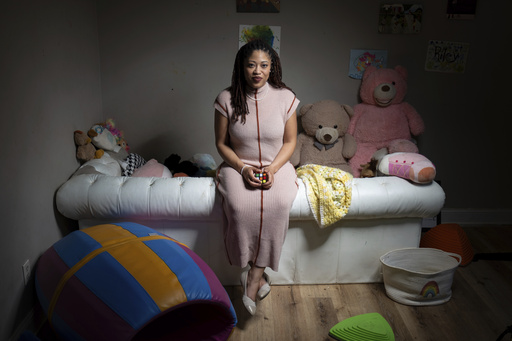
ATLANTA — Natasha Nelson, a 35-year-old business owner from Stone Mountain, Georgia, always found social norms puzzling. She couldn’t comprehend why people preferred engaging in light conversation over more meaningful discussions or the rationale behind daily habits, such as making beds. This confusion persisted until her and her youngest daughter’s autism diagnoses were confirmed a few years ago.
“If your life has always felt chaotic and you’re struggling to feel comfortable and thrive, then what do you have to lose?” Nelson advised others to pursue a diagnosis. Common indicators of autism include difficulties with social interaction and an inclination toward particular routines or interests—Nelson herself notes that “people have become my special interest now.” Many signs of autism may go unrecognized in childhood, making adult diagnosis crucial but challenging.
The task of obtaining an autism diagnosis later in life can be both taxing and costly, as there is a notable lack of healthcare professionals trained to assist adults with autism. It’s essential to understand the key aspects surrounding adult autism assessments.
Autism spectrum disorder encompasses a broad array of challenges related to intellectual functioning, communication, and social skills. Common characteristics include rigid adherence to routines, obsessive interests, and difficulty with nonverbal cues, such as maintaining eye contact. Typically, autism is diagnosed during childhood, with guidelines from the American Academy of Pediatrics advocating for screenings starting at 18 months.
Recently, there has been an uptick in adults seeking insights into their neurodiversity, often triggered by their children’s diagnoses or social media discussions. A study released last year revealed a staggering 452% rise in autism diagnoses among adults aged 26 to 34 between 2011 and 2022.
Many traits associated with autism may remain unnoticed until adulthood when individuals face new social pressures. Additionally, some individuals may learn to mask their symptoms as a coping strategy. “Adults have learned to compensate over time,” noted Whitney Ence, a psychologist from the University of California San Francisco specializing in working with autistic adults. “They may recognize that they can’t display certain behaviors publicly, so they reserve that for private settings.”
The overlap of autism-related symptoms with other disorders like ADHD or OCD can often complicate the diagnosis, especially when factors like nonverbal communication challenges arise.
Symptoms of autism tend to manifest uniquely among individuals. While many traits associated with autism—such as a preference for routines or a fascination with specific topics—are often displayed by those who do not have autism as well, a significant distinction exists. Dr. Arthur Westover, an autism specialist, emphasizes that traits must lead to substantial impairment to qualify for a diagnosis. “People generally enjoy routines; liking a routine doesn’t mean you are autistic,” he remarked, highlighting that the issue is typically deeper than mere preferences.
Russell Lehmann, 34, has navigated life with an autism diagnosis for over two decades. As a motivational speaker, he speaks about the dual nature of his routines; they provide comfort yet also create pressure. He noted that a consistent diet and shopping habits offer him solace, but failing to adhere to a strict daily gym routine leaves him battling feelings of depression and failure. “It’s like no gym, no day,” he stated. “My routine is a significant burden, as I go to bed aware I must follow it to function.”
When considering an autism diagnosis, it’s crucial to understand the process. Despite various online assessment tools, the complexity of autism calls for professionals’ involvement, including discussions with primary care physicians who can provide referrals to psychiatrists. These psychiatrists may wish to consult family and friends from the individual’s childhood who can verify the presence of symptoms during that time.
Standardized diagnostic tests may be administered by a psychologist or be based on clinical judgment since no specific blood test or brain scan exists for autism. The process can be lengthy and expensive; in Nelson’s case, it took three years and over $3,000 in out-of-pocket expenses. Ence recommends that those considering an autism diagnosis reflect on their motivations and be prepared for potential waitlists, asking questions like: “What is prompting me to seek this diagnosis? Do I require access to certain services that I cannot currently obtain?”

